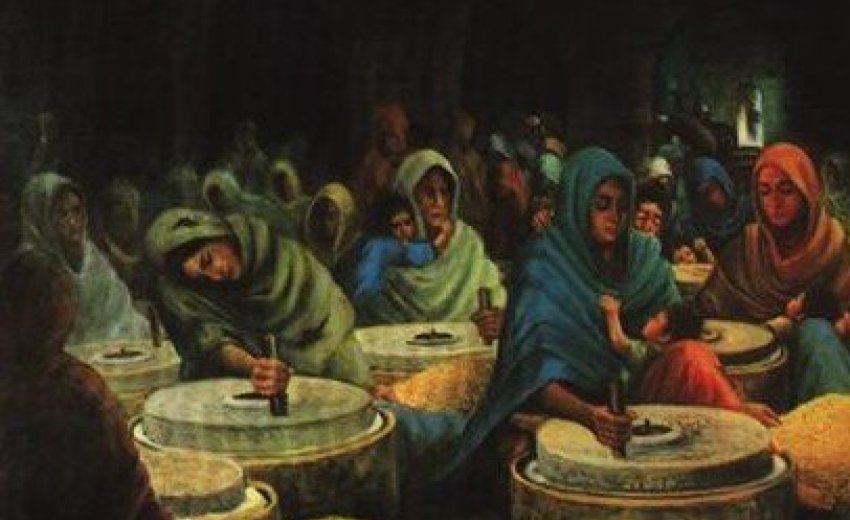Sikh teachings and traditions support equality between men and women.
Sikh teachings and traditions support equality between men and women. In early Sikh history, this allowed women to help achieve Khalsa temporal and ideological (miri-piri) objectives. However, over the past two centuries, the role of a woman has been reduced in the household mostly because of the influence of Hindu Brahmin ideas on Sikh thinking and organizations.
Sakhis-Stories about the Gurus and the history of the 18th century people’s revolution against unfair rulers often talk about the strong influence and contribution of women. This includes women like Bebay Nanaki, Bibi Bhani, and Mata Sundri ji. Sikh women are remembered for making great sacrifices during this time. Later, during the successful period of Khalsa rule, they continued to play important roles in the Sikh community.
Mention of women’s role in Gurmat
Gurmat emphasises on gender equality. It is based on the Sikhi principle that focuses on the spiritual sisterhood of humankind. All are soul-brides of the One Timeless Lord (Akal Purakh) seeking union by aspiring to the status of “sohagan” i.e. one who is beloved of her husband and is respected in the family. A woman who becomes the “sohagan” has been referred to as “batees sulakhani” in Gurbani i.e. one blessed with the proverbial 32 qualities. All men and women can be “sohagan” if they have the qualities necessary to please the Lord. Therefore, man-woman division is a mere technicality in this respect. It matters not whether one has the body of a man or a woman. The path to achieve blissful union with the Timeless Reality (Akal Purakh) is the same for all.
An exemplary quoted shabad is “Why call her bad, who gives birth to kings”. It showcases the importance of gender equality, and how women are equally relevant. As implied by Prof Prabhjot Kaur elsewhere, by stressing the need to develop feminine qualities, Gurbani gives women a head start in achieving the ultimate goal of this human life.
Reforms by Guru Amardas
Guru Amardas (1479 – 1574 Guruship from 1552) carried out major reforms in ensuring that women enjoyed equal congregational (sangat, pangat and sewa ) status with men. He made sure women had the same rights as men in religious gatherings and service. His daughter, Bibi Bhani, helped in religious work. Later, Mata Sundari and Mata Sahib Deva gave advice to the Khalsa after Baba Banda Singh died bravely in Delhi in 1716.
Clearly, significant progress has been accomplished in terms of women's participation in Panthic matters since Guru Amardas Ji appointed the first women missionaries. Khalsa Panth obeyed both of Mata Ji's Hukamnamas. (Those who oppose bibia(n) performing religious or Kirtan seva at Darbar Sahib should consider these historical facts.) It also provides the ideological and traditional context for the Sikh women's enormous commitment to the people's fight of independence from oppressive rule in the 18th century, spearheaded by the Khalsa. All fears that women might not be able to support their male warriors in combat were dispelled by Mai Bhago (Bhag Kaur), who had practiced sword and spear fighting alongside Guru Gobind Singh ji.
Due to the progressive Gurbani perspective, Sikh women were able to manage houses in the anticipated absence of male freedom warriors, which greatly increased the armed struggle's strength and prevented their enemies from doing the same. The daily Ardaas (supplication), which commemorates the martyrdoms (Jinna dharam het sis dittay) and the suffering and tribulations endured, is a historical milestone record in progress that the Khalsa Panth agreed upon after Guru Gobind Singh (1666–1708). It is noteworthy that "Singh-Singhania" (Sikh men and women) are mentioned together. It serves as a reminder of the gender equality embodied in the Gurbani, which Sikh women have achieved by battling with males in the field for dharam-yudh.
Supported by the people of Punjab, Baba Banda Singh
By establishing a fair government, Bahadur demonstrated that Guru Gobind Singh's Khalsa was able to fulfill his political goals of in gareeb Sikhan ko dio(n) patshahi (I shall make these poor Sikhs rulers) and Raj karega Khalsa (the Khalsa shall rule). The Khalsa was also able to defeat the oppressive local rulers and the crumbling Mogul empire. This was a pivotal moment in the people's struggle against oppressive authority in Punjab, which is mostly located north of Delhi and includes Lahore as its capital. The cruelty inflicted on the ordinary people had no bounds.
Historians estimate that more than 250,000 men and women lost their lives at this location in Lahore throughout the eighteenth century. This included the years 1716, when Banda Singh Bahadur was put to death in June of that year in Delhi, and 1753, when Muin-ul-Mulk, also known as Mir Mannu, passed away.
Oppression of women
The power battle between Delhi and the north-west invasions led by Ahmad Shah Durani (also known as Abdali) and Nadir Shah (January to May 1739) further cemented the absolute power of the local rulers. The Turani family, who were not loyal to either Delhi or the invaders, ruled Punjab. They included Abdus Samad Khan (1713–26), who led the capture of Banda Singh Bahadur, his son Zakariya Khan (1726–45), his grandson Yahia Khan (1745–47), and Mir Mannu (1748–53), son of Delhi Wazir Qamr-ud-din Khan (who was Zakariya Khan's brother-in-law). The Delhi emperors Farrukh Siyar, Muhammad Shah (1719–1748), and later Alamgir II were weak.
When Mir Mannu was left alone in March of 1752, he gave Ahmad Shah Abdali Lahore. Punjab was only symbolically recovered by the Moghuls later on. There was no break in the total chaos and absence of civil administration for the population. Around this time, the "rakhi system," or protectorates, wherein individuals paid mercenary bands with money, spread. With the help of the populace, Khalsa "jathas" (groups), which eventually grew into larger misls, grew stronger during this period of power vacuum. Later, once the invaders were completely routed by 1767, the groundwork for the establishment of the Khalsa Raj—a democratic government in which everyone was treated equally—was laid.
People with total power, such as Mir Mannu, wreaked havoc on the common people. Every day, hundreds of people were dragged into chains, subjected to torture, and killed in Lahore, but the people's will to resist oppressive authority became stronger. These deaths and tortures happened in broad daylight. Mannu's name became legend because of the extreme violence he inflicted: "Mannu is our sickle and we are his grass blades; as he cuts us, we grow many times more."
A brief review of Punjab's history at this crucial era reveals that women were the actual victims behind the scenes. The Khalsa warriors were supported by the Sikh ladies who followed Mai Bhag Kaur's example. All historians agree that this was one of the most amazing times in human endurance history—men, women, children, and the elderly refused to give up the fight for freedom in the face of severe torture while being held captive. (Yet, the beginning of the "independence" struggle has left India perplexed.) There aren't many more admirable instances of bravery and tenacity, particularly among women.
The Sikhs' victory was partly attributed to the additional strength of their courageous mothers, sisters, and wives, who not only fulfilled their household responsibilities but also developed proficiency with both the sword and the plough when their male freedom fighters were not there. There was another reason why women who were Sikh, Hindu, and even Muslim were in risk. Bounty hunters chopped the long hair of women, including Muslim women, without any discrimination and presented the heads of "young Sikhs" in order to demand money! Regardless of religion or the masks worn by the leadership, everyone suffers under cruel and oppressive regimes.
Sikh women suffered and worked while being held captive with their small children. Giani Gian Singh[viii] claims, "They were made to grind maize while incarcerated. Many received brutal whippings.A maund and a quarter of grain was provided to each detenus to mill in a single day. The Sikh women worked long hours at their stone mills, exhausted from hunger and thirst, while they sung the songs of their Gurus.
The helpless captives under the dictators' control could do nothing but console their famished and thirsty children as they writhed and cried out on the ground for a scrap of food. The kids would eventually stop sobbing and go to sleep.There were instances where mothers saw their children "hacked to pieces." The pieces of meat were put around their necks and hung on cords.Wherever the Sikhs pray, the fortitude and heroism of those brave women is recalled with reverence.” Gurdwara Shahid Ganj Singhania (opposite Shahid Ganj Bhai Taru Singh) is in remembrance of the Khalsa women and children martyrs.
This was a struggle by the people to overthrow oppressive government. The egalitarian philosophy of Guru Nanak, which regards all men and women, all religions, and all castes as equal before One Creator Being, served as its inspiration. With their fighting might thus increased—both numerically and morally—the Khalsa-led, unstoppable people's army was ultimately certain to triumph over the tyrannical troops. They grew stronger as they encountered more difficulties. They stood up to local persecution and each time the marauders from the northwest returned with their treasures from Indian cities and farmland, they would relieve them of their plunder. Instead of being sold as slaves in their home countries, they saved women and children from these raiders.
Gender equality: lesson for 21st Century
For over 500 years before Guru Nanak Sahib, Islam was the main influence. People followed Islamic practices, including hiding women behind veils. Guru Nanak rejected this practice. Guru Amardas encouraged women to be more involved in the male-dominated world, including in religious matters. He appointed women as preachers.
There are a lot of organizational and gender equality lessons to be learned from the bloodied pages of Sikh history in the eighteenth century. Gender prejudice and Brahmanic social norms still have a significant hold on modern Sikh organizations run by sant samaj deras, or individual religious cults inside the Indian system. Clowning themselves as sants, cholas propagated superstitious anti-Gurmat customs and drew hordes of credulous female devotees, who would otherwise be denied equal rights in gurdwaras and in managing Sikh matters.
Sometimes, Sikh women are not allowed to do religious service in temples. There has been debate about Sikh women singing religious songs at the Golden Temple. However, Bhai Ratan Singh Bhangu wrote that young Jassa Singh Ahluwalia went with his Sikh mother when she sang at the Golden Temple during Nawab Kapur Singh's time (around the mid-18th century).
Prof Prabhjot Kaur says that women today want equality with men because they think men are better. But Sikh holy writings say that women are "the best of the best"(“Sabh parvare mahe sresht”). So, men should follow women's example. The qualities of a devoted wife should be developed by everyone to gain God's attention, no matter if they are men or women.
*Based on an article by Gurmukh Singh, published in sewauk.blogspot.co.uk on 28th December 2015

